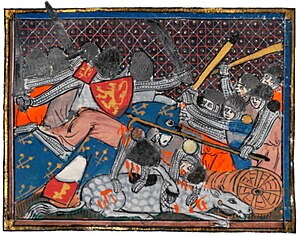
Back Slag van die Goue Spore Afrikaans معركة الرماح الذهبية Arabic Qızıl mahmuzlar döyüşü Azerbaijani Битка при Куртре Bulgarian Emgann ar C'hentroù Aour Breton Batalla de Kortrijk Catalan Bitva u Courtrai Czech Guldsporeslaget Danish Sporenschlacht German Batalo de la oraj spronoj Esperanto
| Battle of the Golden Spurs | |||||||
|---|---|---|---|---|---|---|---|
| Part of the Franco-Flemish War | |||||||
 Depiction from the Grandes Chroniques de France | |||||||
| |||||||
| Belligerents | |||||||
|
County of Flanders County of Namur | Kingdom of France | ||||||
| Commanders and leaders | |||||||
|
William of Jülich Guy of Namur John I of Namur Pieter de Coninck Jan Borluut Jan van Renesse | John I, Count of Dammartin †[2] | ||||||
| Strength | |||||||
|
8,400–10,400 8,000–10,000 militia infantry[2][3] 400 men-at-arms[2] |
8,000–8,500 1,000 pikemen[2] 1,000 crossbowmen[2] 3,500 assorted infantry[2] 2,500–3,000 men-at-arms and knights[2][3] | ||||||
| Casualties and losses | |||||||
| ~100–300 killed[4] | ~1,000–1,500 men-at-arms and knights killed[5][6] | ||||||
Battlefield on a map of modern Belgium | |||||||
The Battle of the Golden Spurs (Dutch: Guldensporenslag; French: Bataille des éperons d'or) or 1302 Battle of Courtrai was a military confrontation between the royal army of France and rebellious forces of the County of Flanders on 11 July 1302 during the 1297–1305 Franco-Flemish War. It took place near the town of Kortrijk in modern-day Belgium and resulted in an unexpected victory for the Flemish.
On 18 May 1302, after two years of French military occupation and several years of unrest, many cities in Flanders revolted against French rule, and the local militia massacred many Frenchmen in the city of Bruges. King Philip IV of France immediately organized an expedition of 8,000 troops, including 2,500 men-at-arms, under Count Robert II of Artois to put down the rebellion. Meanwhile, 9,400 men from the civic militias of several Flemish cities were assembled to counter the expected French attack.
When the two armies met outside the city of Kortrijk on 11 July, the cavalry charges of the mounted French men-at-arms were unable to defeat the mail-armoured and well-trained Flemish militia infantry's pike formation. The result was a rout of the French nobles, who suffered heavy losses at the hands of the Flemish. The 500 pairs of spurs that were captured from the French horsemen gave the battle its popular name. The battle was a famous early example of an all-infantry army defeating an enemy force reliant on heavy cavalry by means of superior numbers, the environment, and by taking advantage of their foes' overconfidence.
While France was victorious in the overall Franco-Flemish War, the Battle of the Golden Spurs became an important cultural reference point for the Flemish Movement during the 19th and 20th centuries. In 1973, the date of the battle was chosen for the official holiday of the Flemish Community in Belgium. A 1985 film called De leeuw van Vlaanderen (The Lion of Flanders) depicts a vision of the battle, and the politics that led up to it.[7]
- ^ Rogers 1999, p. 137.
- ^ a b c d e f g h Tucker 2010, p. 294.
- ^ a b Verbruggen 1997, p. 190.
- ^ Verbruggen 1997, p. 194.
- ^ Rogers 1999, p. 141.
- ^ Verbruggen 2002, p. 193.
- ^ "IMDb entry". IMDb. Archived from the original on 22 November 2021. Retrieved 22 November 2021.
